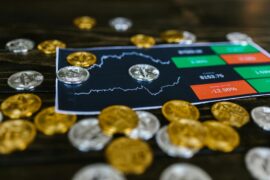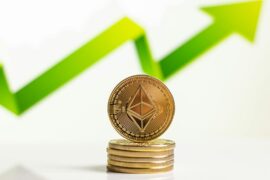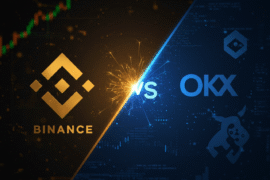This article may contain references to products or services from one or more of our advertisers or partners. We may receive compensation when you click on links to those products or services. Nonetheless, our opinions are our own.

Updated by Albert Fang
Several years ago, NFTs were first used to sell digital artwork through a crypto network. Now, the digital art market is booming, with NFTs selling for millions of dollars every day. But what is an NFT, and how do blockchain and cryptocurrencies influence the world of art?
What is Blockchain
Blockchain networks are encrypted, immutable ledgers of exchange that host cryptocurrencies and NFTs (non-fungible tokens). Blockchain networks cannot be tampered with, and they provide more transparency around deal-making and how money moves between parties. The technology of blockchain networks has many applications beyond cryptocurrency exchange. Blockchain networks can reduce the risk of any transaction, store large amounts of data reliably and securely, and facilitate decentralized transactions without intermediaries such as banks. Blockchain technology is becoming more and more popular in business and digital exchange. Still, in the last several years, the effect of blockchain networks on the art industry has been tremendous.
What are NFTs
Non-fungible tokens are like cryptocurrencies, but NFTs cannot be traded one to one. Each NFT is unique and can represent digital or tangible assets. NFTs can be used for digital art, smart contracts, videos, or other coded data. NFTs are bought and sold using cryptocurrencies. NFT marketplaces make it easy for anyone to learn how to create or how to invest in NFTs. Investing in NFTs can be a super lucrative endeavor. Much like collecting real-life pieces of original art or collectibles, many NFTs will appreciate over time, making them a popular long-term investment option.
NFTs and Artists
NFTs can represent anything, but most commonly, NFTs are used to mint digital artworks. Each digital art NFT contains the code of a piece of art and information about the original artist and each person who’s owned the work since its initial sale. NFTs are helping digital artists solve issues of provenance and valuation that have long challenged the ability of digital artists to market their creations reliably. With NFTs, no matter how many times a digital artwork is sold and resold, the original artist will always be recorded in the code of the NFT. When selling NFTs, artists can opt for royalty payments paid to them each time the piece is resold. NFT marketplaces such as that at FTX are explicitly built for digital artists to easily mint, list, sell and auction their digital artworks. NFT marketplaces also make it easy for collectors to discover and communicate with the digital artist.
Selling on the NFT Marketplace
Selling your work on an NFT marketplace is simple. First, select the marketplace and cryptocurrency you’d prefer to use to mint and sell your NFT. The cryptocurrency you choose should be compatible with the marketplace you want to be listed on. Open a digital wallet and purchase some cryptocurrency; there are many digital wallet apps you can choose from. Once you’ve funded your wallet, you can log in to the NFT marketplace and mint your first NFT. Minting your NFT adds it to the blockchain network of the cryptocurrency you selected. Your NFT can now be sold and auctioned on the blockchain. You have the option to mint one NFT of each unique digital artwork you create, or you can mint a limited number of each artwork. Remember that when you sell an NFT, you are essentially selling the rights to that image along with a coded certificate of authenticity and originality.
With blockchain and NFTs, artists have a secure and accessible marketplace to sell their digital intellectual property. The value of digital artworks has never been higher, with more and more artists, collectors, and investors endorsing the value of the NFT marketplace every day.

Reviewed and edited by Albert Fang.
See a typo or want to suggest an edit/revision to the content? Use the contact us form to provide feedback.
At FangWallet, we value editorial integrity and open collaboration in curating quality content for readers to enjoy. Much appreciated for the assist.
Did you like our article and find it insightful? We encourage sharing the article link with family and friends to benefit as well - better yet, sharing on social media. Thank you for the support! 🍉
Article Title: How Crypto is Changing the Art World
https://fangwallet.com/2022/04/01/how-crypto-is-changing-the-art-world/The FangWallet Promise
FangWallet is an editorially independent resource - founded on breaking down challenging financial concepts for anyone to understand since 2014. While we adhere to editorial integrity, note that this post may contain references to products from our partners.
The FangWallet promise is always to have your best interest in mind and be transparent and honest about the financial picture.
Become an Insider

Subscribe to get a free daily budget planner printable to help get your money on track!
Make passive money the right way. No spam.
Editorial Disclaimer: The editorial content on this page is not provided by any of the companies mentioned. The opinions expressed here are the author's alone.
The content of this website is for informational purposes only and does not represent investment advice, or an offer or solicitation to buy or sell any security, investment, or product. Investors are encouraged to do their own due diligence, and, if necessary, consult professional advising before making any investment decisions. Investing involves a high degree of risk, and financial losses may occur including the potential loss of principal.
Source Citation References:
+ Inspo











































